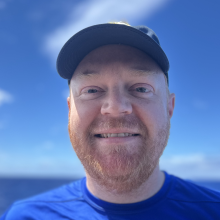
Aaron Steiner
Tell us about your work/research. What kinds of things do you do?
I lead the Engineering and Product Development team at DeepSea Power & Light, where I have been on staff for 15 years, developing imaging systems for subsea applications. My technical background is in Electrical Engineering and I specialize in systems design, power electronics, sensing, instrumentation, optics, and manufacturing.
What this really means is that I get to geek out over cameras and the latest imaging technology, then come up with innovative ways to get it in the hands of other engineers and scientists exploring the oceans. I never get tired of seeing the amazing results of what others are able to do with the tools we develop here at DeepSea!
What sparked your initial interest in your career?
While I was an early career engineer, I was lucky to work somewhere that gave me broad exposure to many different technical disciplines, from materials science to biotechnology. This gave me an appreciation for working in multidisciplinary teams, and I was inspired by the challenge and camaraderie that come from solving difficult problems with a diverse group.
As I explored opportunities to grow and focus my career I initially looked to the stars. I was laying the foundation for working in planetary science when I stumbled upon an engineering role at DeepSea Power & Light. I decided to join the team, switching from exploring outer space to exploring inner space. The technical challenges were unique, inherently multidisciplinary, and I quickly became entranced with the alien worlds just below the waves.
Who influenced you or encouraged you the most?
Three people come to mind for me: Jim Moore who supervised me during my co-op job when I was an undergrad. He showed me that no project was too big if you break it down and work to understand the system. Mark Olsson, my boss at DeepSea, who, even more than his technical brilliance, inspires me with his boundless curiosity and tolerance for imperfect squishy meat brains that constantly try to trick us. And finally, Mandy Steiner, my best friend, partner, and mother of our amazing kid who, more than anyone, has shown me grace and encourages me every step of the way.
What element of your work/study do you think is the most fascinating?
For me, the most captivating part of my work is what other people do with it. I design cool imaging tools, but the questions others work to answer with them and the places they are used are exponentially more fascinating.
How did you get involved with the Ocean Exploration Trust?
I was invited aboard E/V Nautilus to support field trials of our new ultra-high definition subsea video system - the MxD SeaCam. We began development in 2019 as a joint project with the Monterey Aquarium Research Institute (MBARI) and are now testing a commercial version of the system rated for 7000m operations. As we approached the launch of the MxD system, our team looked for partners to test the new camera out with. OET had an upcoming expedition that provided both of our organizations with unique opportunities. For DeepSea, we will be able to field the camera with one of the most capable and experienced deep ocean exploration teams in the world while OET gets first look at the MxD camera along with what should be some spectacular and compelling 4K footage.
What other jobs led you to your current career?
It wasn't so much the other jobs I had that led me to a career designing subsea imaging equipment - it was the job I wanted in planetary science. During 2010, I was relocating back to Southern California and angling to get a job with a company that built cameras for JPL and NASA. I stumbled upon DeepSea Power & Light in the process, and the parallels of a company building cameras for underwater exploration were intriguing. It was a good fit both technically and personally. I quickly found myself feeling both connected and committed to the oceanographic community and the work we were doing.
What are your degrees and certifications?
Bachelors of Engineering in Electrical Engineering -- Auburn University 2006
What are your hobbies?
I enjoy photography, stargazing, reading, camping, hiking, and building worlds in Minecraft with my kid - really anything where I find mindful moments and peacefulness when I need a break. I also find baking desserts for friends and family richly rewarding.
What advice would you give someone who wants to have a career like yours?
The best engineers I have worked with aren't afraid to ask questions. Equally important, they are open to answers, even when, and perhaps especially when, those answers challenge what they think they understand. When an experiment or test doesn't work the way you predicted or expected, that is when you should get excited. You have a chance to learn something new and interesting about the world. This commitment to curiosity is a skill. It can be practiced and improved through exercise and repetition just like any other skill.
Expeditions
Aaron participated in the following Ocean Exploration Trust expeditions:
